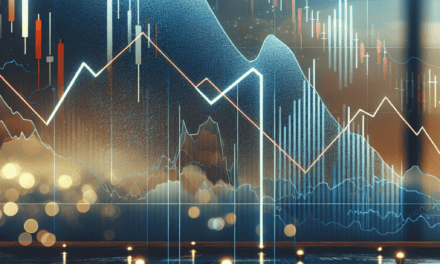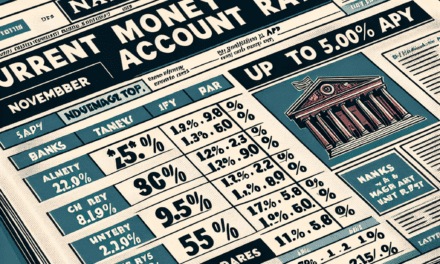“Market Surge: Wall Street Soars with Small Caps and Tesla Leading the Charge Amid Fed’s Rate Cut!”
Introduction
Market Surge: Wall Street Hits Record Highs as Small Caps and Tesla Outperform Amid Fed Rate Cut
In a remarkable turn of events, Wall Street has reached unprecedented heights, driven by a robust performance from small-cap stocks and a notable surge in Tesla’s market value. This bullish momentum comes on the heels of a strategic interest rate cut by the Federal Reserve, aimed at stimulating economic growth and investor confidence. The rate cut has provided a favorable environment for equities, particularly benefiting smaller companies and high-growth stocks like Tesla, which have outpaced broader market indices. As investors navigate this dynamic landscape, the interplay between monetary policy and market performance continues to shape the financial narrative, highlighting the resilience and adaptability of the U.S. stock market.
Impact Of Fed Rate Cut On Wall Street’s Record Highs
The recent decision by the Federal Reserve to implement a rate cut has sent ripples through the financial markets, culminating in Wall Street reaching unprecedented record highs. This monetary policy adjustment, aimed at stimulating economic growth, has had a profound impact on various sectors, with small-cap stocks and Tesla emerging as notable beneficiaries. As investors digest the implications of the Fed’s actions, the broader market landscape is experiencing a significant transformation.
To begin with, the Federal Reserve’s rate cut has lowered borrowing costs, thereby encouraging businesses to invest and expand. This move is particularly advantageous for small-cap companies, which often rely heavily on borrowing to finance their operations. As a result, these smaller firms have seen a surge in investor interest, driving their stock prices upward. The Russell 2000 index, which tracks the performance of small-cap stocks, has outperformed larger indices, reflecting the renewed confidence in these companies’ growth prospects. This shift in investor sentiment underscores the critical role that monetary policy plays in shaping market dynamics.
Simultaneously, the rate cut has provided a tailwind for Tesla, the electric vehicle giant, which has been on an impressive upward trajectory. Lower interest rates reduce the cost of capital for Tesla, facilitating its ambitious expansion plans and bolstering its competitive edge in the rapidly evolving automotive industry. Moreover, the rate cut has also contributed to a more favorable environment for consumer spending, potentially increasing demand for Tesla’s innovative products. Consequently, Tesla’s stock has surged, further propelling Wall Street to new heights.
In addition to these sector-specific impacts, the Fed’s rate cut has broader implications for the overall market. By making borrowing cheaper, the rate cut encourages both consumer spending and business investment, which are vital components of economic growth. This, in turn, boosts corporate earnings, a key driver of stock market performance. As companies report stronger financial results, investor confidence is bolstered, leading to increased buying activity and pushing stock indices to record levels.
Furthermore, the rate cut has also influenced the bond market, with yields on government securities declining. This development has prompted investors to seek higher returns in the stock market, contributing to the upward momentum in equities. The interplay between bond yields and stock prices highlights the interconnectedness of financial markets and the far-reaching effects of monetary policy decisions.
While the immediate impact of the Fed’s rate cut has been overwhelmingly positive for Wall Street, it is essential to consider the potential long-term consequences. Lower interest rates can lead to increased risk-taking by investors, potentially inflating asset bubbles. Additionally, if the economy overheats, the Fed may be compelled to reverse course and raise rates, which could dampen market enthusiasm. Therefore, while the current market surge is a cause for celebration, it is crucial for investors to remain vigilant and consider the broader economic context.
In conclusion, the Federal Reserve’s recent rate cut has played a pivotal role in propelling Wall Street to record highs, with small-cap stocks and Tesla emerging as standout performers. By reducing borrowing costs and stimulating economic activity, the rate cut has created a favorable environment for both businesses and consumers. However, as the market continues to evolve, it is imperative for investors to stay informed and adapt to changing conditions, ensuring that they are well-positioned to navigate the complexities of the financial landscape.
Small Caps Outperforming: A Closer Look At Market Dynamics
In recent weeks, Wall Street has experienced a remarkable surge, with major indices reaching record highs. This bullish trend has been driven by a confluence of factors, including the Federal Reserve’s decision to cut interest rates, which has injected renewed optimism into the market. Among the standout performers in this rally are small-cap stocks and Tesla, both of which have outpaced broader market gains. To understand the dynamics at play, it is essential to delve into the factors contributing to the outperformance of small caps and the implications of the Fed’s monetary policy shift.
Small-cap stocks, often seen as a barometer for domestic economic health, have been on a tear, outperforming their larger counterparts. This outperformance can be attributed to several key factors. Firstly, small-cap companies are generally more sensitive to changes in domestic economic conditions. The Fed’s rate cut has lowered borrowing costs, providing a significant boost to these companies, which often rely more heavily on debt financing. Additionally, the rate cut has alleviated some of the pressure from rising interest expenses, thereby improving profit margins and enhancing investor sentiment.
Moreover, small-cap stocks tend to benefit from a stronger U.S. dollar, which has been bolstered by the Fed’s dovish stance. A robust dollar makes imports cheaper and can lead to increased consumer spending, which in turn benefits small-cap companies that are more domestically focused. Furthermore, the recent tax reforms have disproportionately favored smaller companies, providing them with additional capital to reinvest in growth initiatives. This has created a favorable environment for small caps to thrive, as they are better positioned to capitalize on domestic economic expansion.
In parallel, Tesla has emerged as a standout performer, capturing the attention of investors and analysts alike. The electric vehicle manufacturer has seen its stock price soar, driven by a combination of strong sales figures, expanding production capabilities, and growing consumer demand for sustainable transportation solutions. Tesla’s ability to consistently exceed market expectations has reinforced investor confidence, propelling its stock to new heights. Additionally, the company’s strategic initiatives, such as the expansion of its Gigafactories and the introduction of new models, have further solidified its position as a leader in the automotive industry.
The Fed’s decision to cut interest rates has played a pivotal role in this market rally, as it signals a shift towards a more accommodative monetary policy. By reducing borrowing costs, the Fed aims to stimulate economic activity and counteract potential headwinds. This move has been well-received by investors, who view it as a proactive measure to sustain economic growth. The rate cut has also contributed to a more favorable environment for equities, as lower interest rates make stocks more attractive relative to fixed-income investments.
In conclusion, the recent market surge, characterized by record highs on Wall Street, has been driven by the outperformance of small-cap stocks and Tesla, amid the backdrop of a Fed rate cut. The dynamics at play highlight the sensitivity of small caps to domestic economic conditions and the strategic positioning of Tesla within the automotive sector. As the market continues to navigate this evolving landscape, investors will be closely monitoring the interplay between monetary policy, economic indicators, and corporate performance. This period of heightened market activity underscores the importance of understanding the underlying factors that drive stock performance and the broader implications for the investment landscape.
Tesla’s Role In The Recent Market Surge
In recent weeks, Wall Street has experienced a remarkable surge, with major indices reaching record highs. This upward momentum has been driven by a confluence of factors, including the Federal Reserve’s decision to cut interest rates and the impressive performance of small-cap stocks. However, one of the most significant contributors to this market rally has been Tesla, whose stock has outperformed expectations and played a pivotal role in the broader market’s ascent.
Tesla’s influence on the market cannot be overstated. As a leading player in the electric vehicle industry, Tesla has consistently captured the attention of investors and analysts alike. The company’s innovative approach to sustainable transportation and energy solutions has positioned it as a bellwether for the tech-driven segment of the market. Recently, Tesla’s stock has seen a substantial increase, driven by strong quarterly earnings, robust vehicle delivery numbers, and positive developments in its global expansion efforts. These factors have not only bolstered investor confidence in Tesla but have also contributed to the overall optimism in the market.
Moreover, Tesla’s performance has had a ripple effect on related sectors, further amplifying its impact on the market surge. For instance, companies involved in the production of electric vehicle components and battery technology have also experienced gains, as investors anticipate increased demand for these products. This interconnectedness highlights Tesla’s role as a catalyst for growth within the broader market ecosystem.
In addition to Tesla’s individual achievements, the Federal Reserve’s recent decision to cut interest rates has provided a favorable backdrop for the market’s upward trajectory. Lower interest rates typically reduce borrowing costs for businesses and consumers, encouraging spending and investment. This monetary policy shift has been particularly beneficial for growth-oriented companies like Tesla, which often rely on external financing to fund their ambitious projects and expansion plans. Consequently, the rate cut has further fueled investor enthusiasm for Tesla and similar high-growth stocks.
Furthermore, the performance of small-cap stocks has complemented Tesla’s success, contributing to the overall market surge. Small-cap companies, often characterized by their agility and potential for rapid growth, have benefited from the improved economic outlook and increased investor appetite for riskier assets. As these companies continue to demonstrate resilience and adaptability, they have attracted significant attention from investors seeking opportunities beyond the traditional large-cap stocks. This diversification of investment interest has helped sustain the market’s upward momentum.
While Tesla’s role in the recent market surge is undeniable, it is essential to consider the broader context in which this rally is occurring. The combination of favorable monetary policy, strong corporate earnings, and investor optimism has created an environment conducive to market growth. However, it is crucial for investors to remain vigilant and consider potential risks, such as geopolitical tensions and economic uncertainties, that could impact future market performance.
In conclusion, Tesla’s remarkable performance has been a key driver of the recent market surge, underscoring its significance within the financial landscape. As the company continues to innovate and expand its global footprint, its influence on the market is likely to persist. Nevertheless, the interplay of various factors, including Federal Reserve policies and the performance of small-cap stocks, will continue to shape the trajectory of Wall Street in the coming months. Investors should remain attentive to these dynamics as they navigate the evolving market landscape.
Analyzing The Factors Behind Wall Street’s Record Highs
Wall Street has recently experienced a remarkable surge, with major indices reaching record highs, driven by a confluence of factors that have invigorated investor sentiment. Among the standout performers in this rally are small-cap stocks and Tesla, both of which have outpaced broader market gains. This upward momentum has been further bolstered by the Federal Reserve’s decision to cut interest rates, a move that has injected fresh optimism into the financial markets.
To begin with, the Federal Reserve’s rate cut has played a pivotal role in propelling Wall Street to new heights. By lowering interest rates, the Fed has effectively reduced the cost of borrowing, encouraging both consumer spending and business investment. This monetary policy adjustment is designed to stimulate economic growth, particularly in a climate where inflationary pressures have been relatively subdued. As a result, investors have been emboldened to seek higher returns in the stock market, driving up demand for equities and contributing to the record highs observed in recent weeks.
In addition to the favorable monetary policy environment, small-cap stocks have emerged as significant contributors to the market’s robust performance. These stocks, which represent smaller companies with a market capitalization typically below $2 billion, have benefited from a renewed focus on domestic economic growth. As the U.S. economy shows signs of resilience, investors have increasingly turned to small-cap stocks, which are often more sensitive to domestic economic conditions than their larger counterparts. This shift in investor preference has led to a notable outperformance of small-cap indices, further fueling the overall market rally.
Moreover, Tesla’s exceptional performance has captured the attention of market participants and analysts alike. The electric vehicle manufacturer has consistently exceeded expectations, both in terms of vehicle deliveries and financial results. Tesla’s ability to innovate and expand its market share in the rapidly growing electric vehicle sector has positioned it as a leader in the transition to sustainable transportation. Consequently, Tesla’s stock has surged, contributing significantly to the upward trajectory of major indices, particularly the Nasdaq Composite, where it holds a substantial weighting.
Furthermore, the broader economic landscape has provided a supportive backdrop for Wall Street’s ascent. Despite ongoing geopolitical uncertainties and trade tensions, the U.S. economy has demonstrated resilience, with key indicators such as employment and consumer spending remaining robust. This economic stability has reassured investors, who have been willing to overlook short-term volatility in favor of long-term growth prospects. Additionally, corporate earnings have generally exceeded expectations, providing further impetus for stock price appreciation.
In conclusion, Wall Street’s record highs can be attributed to a combination of factors, including the Federal Reserve’s accommodative monetary policy, the outperformance of small-cap stocks, and Tesla’s remarkable success. These elements, coupled with a resilient U.S. economy and strong corporate earnings, have created an environment conducive to market growth. As investors continue to navigate this dynamic landscape, the interplay of these factors will likely remain central to the ongoing evolution of financial markets. While challenges and uncertainties persist, the current market surge underscores the resilience and adaptability of both the economy and the financial markets in the face of changing conditions.
The Influence Of Federal Reserve Policies On Stock Market Trends
The recent surge in the stock market, marked by Wall Street reaching record highs, has been significantly influenced by the Federal Reserve’s monetary policies, particularly its decision to cut interest rates. This strategic move by the Fed has not only buoyed investor confidence but also stimulated economic activity, leading to a notable outperformance by small-cap stocks and Tesla. Understanding the intricate relationship between Federal Reserve policies and stock market trends is crucial for investors and analysts alike.
To begin with, the Federal Reserve’s decision to cut interest rates is primarily aimed at stimulating economic growth by making borrowing cheaper for businesses and consumers. Lower interest rates reduce the cost of capital, encouraging companies to invest in expansion and innovation. This, in turn, can lead to increased corporate earnings, which are a key driver of stock prices. Consequently, the stock market often reacts positively to rate cuts, as they signal a more accommodative monetary environment.
In this context, small-cap stocks have shown remarkable resilience and growth. These stocks, representing smaller companies with a market capitalization typically under $2 billion, are often more sensitive to changes in interest rates compared to their larger counterparts. The reason for this sensitivity lies in their reliance on borrowing to finance growth initiatives. With lower interest rates, small-cap companies can access cheaper financing, allowing them to expand operations, invest in new projects, and ultimately enhance their profitability. As a result, investors have flocked to small-cap stocks, driving their prices higher and contributing to the overall market surge.
Simultaneously, Tesla has emerged as a standout performer amid the broader market rally. The electric vehicle manufacturer has consistently captured investor attention with its innovative products and ambitious growth plans. The Fed’s rate cut has further amplified Tesla’s appeal by reducing the cost of financing for both the company and its customers. Lower interest rates make it more affordable for consumers to finance electric vehicle purchases, potentially boosting Tesla’s sales. Additionally, the company can benefit from cheaper capital to fund its expansion into new markets and the development of cutting-edge technologies. These factors have combined to propel Tesla’s stock to new heights, reinforcing its position as a market leader.
Moreover, the Federal Reserve’s policies have broader implications for investor sentiment and market dynamics. By signaling a commitment to supporting economic growth, the Fed instills confidence in investors, encouraging them to take on more risk. This increased risk appetite can lead to higher stock valuations, as investors are willing to pay a premium for future growth prospects. Furthermore, the Fed’s actions can influence global markets, as other central banks may adjust their policies in response, creating a ripple effect that impacts international investment flows.
In conclusion, the Federal Reserve’s decision to cut interest rates has played a pivotal role in driving the recent stock market surge, with small-cap stocks and Tesla emerging as notable beneficiaries. By fostering a more favorable economic environment, the Fed’s policies have enhanced investor confidence and stimulated market activity. As the interplay between monetary policy and stock market trends continues to evolve, understanding these dynamics remains essential for navigating the complexities of the financial landscape.
Investment Strategies Amid Market Surge And Fed Rate Cuts
The recent surge in the stock market, marked by Wall Street reaching record highs, has captured the attention of investors and analysts alike. This remarkable performance is largely attributed to the impressive gains in small-cap stocks and the standout performance of Tesla, all occurring in the context of a Federal Reserve rate cut. As investors navigate this dynamic environment, it is crucial to consider strategic approaches that align with the current market conditions.
To begin with, the Federal Reserve’s decision to cut interest rates has played a pivotal role in the recent market rally. Lower interest rates generally reduce the cost of borrowing, encouraging both consumer spending and business investment. This monetary policy move is designed to stimulate economic growth, and it often leads to increased investor confidence. Consequently, the stock market tends to respond positively, as seen in the recent surge. Investors should consider how these macroeconomic factors influence their portfolio strategies, particularly in terms of asset allocation and risk management.
In this context, small-cap stocks have emerged as significant beneficiaries of the current market conditions. These stocks, typically representing smaller companies with a market capitalization of less than $2 billion, are often more sensitive to changes in economic conditions and interest rates. The recent rate cut has provided a favorable environment for these companies to thrive, as lower borrowing costs can enhance their growth prospects. Investors looking to capitalize on this trend might consider increasing their exposure to small-cap stocks, while also being mindful of the inherent volatility and risks associated with this asset class.
Moreover, Tesla’s exceptional performance has been a focal point in the market’s upward trajectory. The electric vehicle manufacturer has consistently exceeded market expectations, driven by strong sales figures, innovative product launches, and strategic expansions into new markets. Tesla’s success underscores the importance of identifying companies with robust growth potential and a clear competitive advantage. Investors may benefit from analyzing similar high-growth companies that are well-positioned to capitalize on emerging trends, such as renewable energy and technological innovation.
As the market continues to evolve, diversification remains a key principle for investors seeking to optimize their portfolios. While small caps and high-growth stocks like Tesla offer attractive opportunities, it is essential to maintain a balanced approach that includes a mix of asset classes and sectors. This strategy can help mitigate risks and enhance long-term returns, particularly in a market characterized by rapid changes and uncertainties.
Furthermore, investors should remain vigilant and adaptable, as market conditions can shift quickly. Monitoring economic indicators, corporate earnings reports, and geopolitical developments can provide valuable insights into potential market movements. Staying informed and being prepared to adjust investment strategies in response to new information is crucial for navigating the complexities of the current market environment.
In conclusion, the recent market surge, driven by small caps and Tesla’s outperformance amid a Fed rate cut, presents both opportunities and challenges for investors. By understanding the underlying factors contributing to this rally and adopting strategic investment approaches, investors can position themselves to capitalize on the current market dynamics while managing risks effectively. As always, a disciplined and informed approach will be key to achieving investment success in this ever-changing landscape.
Future Outlook: Sustainability Of Current Market Trends
The recent surge in the stock market, marked by Wall Street reaching record highs, has captured the attention of investors and analysts alike. This remarkable performance has been driven in part by the impressive gains in small-cap stocks and the notable outperformance of Tesla. These developments have occurred against the backdrop of a Federal Reserve rate cut, which has further fueled optimism in the financial markets. As we look to the future, the sustainability of these current market trends becomes a focal point of discussion, raising questions about the underlying factors that could influence their persistence.
To begin with, the Federal Reserve’s decision to cut interest rates has played a pivotal role in the recent market rally. Lower interest rates generally reduce the cost of borrowing, encouraging both consumer spending and business investment. This monetary policy move has provided a significant boost to market sentiment, as investors anticipate that cheaper credit will stimulate economic growth. However, it is essential to consider whether this rate cut is a temporary measure or part of a longer-term strategy. If the latter, the market could continue to benefit from a favorable interest rate environment, supporting sustained growth.
Moreover, the outperformance of small-cap stocks is another critical factor contributing to the current market dynamics. Small-cap companies, often seen as more sensitive to domestic economic conditions, have shown resilience and adaptability in the face of recent challenges. Their strong performance suggests a renewed confidence in the U.S. economy, as these companies are typically more reliant on local markets than their larger counterparts. Nevertheless, the sustainability of this trend will depend on the broader economic landscape, including factors such as consumer confidence, employment rates, and fiscal policies.
Tesla’s remarkable performance has also been a significant driver of the market’s upward trajectory. The electric vehicle manufacturer has consistently exceeded expectations, both in terms of production capabilities and market penetration. Tesla’s success underscores the growing importance of sustainable technologies and the increasing demand for environmentally friendly products. As the world continues to prioritize sustainability, companies like Tesla are well-positioned to capitalize on this shift. However, the competitive landscape in the electric vehicle market is rapidly evolving, and Tesla’s ability to maintain its leadership position will be crucial for its continued success.
In addition to these factors, geopolitical developments and global economic conditions will inevitably influence the sustainability of current market trends. Trade relations, particularly between major economies, can have far-reaching implications for market stability. Any significant disruptions or escalations could potentially dampen investor confidence and alter the trajectory of the market. Furthermore, the ongoing recovery from the global pandemic remains a critical variable, as it continues to shape economic policies and consumer behavior worldwide.
In conclusion, while the recent market surge has been driven by a confluence of factors, including the Federal Reserve’s rate cut, the outperformance of small caps, and Tesla’s success, the sustainability of these trends is contingent upon a complex interplay of economic, political, and technological forces. Investors and analysts must remain vigilant, continuously assessing these variables to navigate the ever-evolving financial landscape. As we move forward, the ability to adapt to changing conditions and anticipate future developments will be paramount in determining the longevity of the current market trends.
Q&A
1. **What is the main event described in the article?**
Wall Street has hit record highs as small-cap stocks and Tesla outperform amid a Federal Reserve rate cut.
2. **Which sectors or stocks are highlighted as outperforming?**
Small-cap stocks and Tesla are highlighted as outperforming.
3. **What action did the Federal Reserve take that influenced the market?**
The Federal Reserve implemented a rate cut.
4. **How did the rate cut affect investor sentiment?**
The rate cut boosted investor sentiment, contributing to the market surge.
5. **What impact did the market surge have on Wall Street?**
The market surge led to record highs on Wall Street.
6. **Why might small-cap stocks have outperformed in this scenario?**
Small-cap stocks often benefit from lower interest rates, which can reduce borrowing costs and stimulate growth.
7. **What is the significance of Tesla’s performance in the market?**
Tesla’s strong performance may indicate investor confidence in its growth prospects and innovation, contributing to its outperformance.
Conclusion
The recent market surge, marked by record highs on Wall Street, highlights a robust investor response to the Federal Reserve’s decision to cut interest rates. This monetary policy adjustment has provided a favorable environment for equities, particularly benefiting small-cap stocks and Tesla, which have outperformed broader indices. The rate cut has likely alleviated some economic concerns, encouraging investment in growth-oriented sectors and companies. Tesla’s strong performance may also reflect investor confidence in its strategic initiatives and market position. Overall, the market’s positive reaction underscores the significant influence of central bank policies on investor sentiment and market dynamics.





